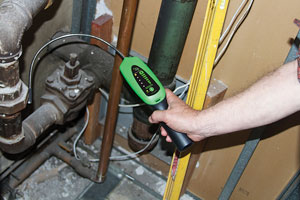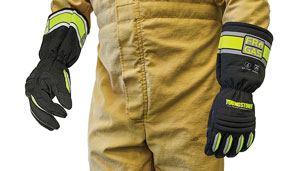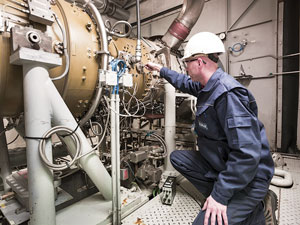New in gas processing technology
A. Blume, Editor
Combustible gas detector for industrial systems

Industrial maintenance technicians need to be vigilant in inspecting gas systems to ensure that they are working to maximum capability. Without proper attention, the results can include gas losses, gas purity issues and other safety concerns, such as fire or asphyxiation.
Spectronics Corp.’s Spectroline PRO-Chek CG combustible gas leak detector (P/N CG-1000) effectively detects gas leaks in industrial systems. The PRO-Chek CG detector is designed to find leaks in natural gas systems, propane tanks, pipelines, regulators and valves, heat exchangers and much more. The unit detects natural gas, propane, ammonia, methanol, ethanol, ethane, butane and other gases.
The PRO-Chek CG detector is also certified as intrinsically safe for use in combustive and explosive environments. The instrument is claimed to be twice as sensitive as competitive units, and it features an adjustable sensitivity control to quickly pinpoint the exact location of every leak.
Additional features include a variable-intensity audible alarm and flashing LED lights to determine the size and strength of the leak. An auto-zeroing function blocks out background gas levels in the test area. The detector’s chrome-plated, flexible metal probe allows for leak checking in tight places. The PRO-Chek CG detector comes with a sensor, D-cell batteries and a reinforced carrying case.
Flashing sounder for toxic gas detection

Pfannenberg’s PATROL model PA X 1-05 is an audible alarm sounder with a flashing strobe light. The device is designed to perform as a hazardous gas warning alarm when connected
to the remote alarm relay of a toxic or combustible gas detector controller.
The nominal 100-dB sounder has an onboard selection of 80 different alarm tones and a maximum output of 105 dB, thereby permitting its use as a notification appliance for evacuation purposes in noisy, industrial environments. The unit is also capable of producing a different tone for up to four unique events, allowing different sounds to be assigned for different gases, or one tone for warning levels and another tone for alarm levels.
The 5-Joule flashing Xenon strobe light ensures visual alarm perception in noisy environments or where hearing protection is used. The light can be operated simultaneously with the sounder, or controlled separately from it. A choice of lens colors tailors the unit to suit the user’s preference. Typical lens color choices are red for combustible gas and blue for toxic gases.
Additional features include a red or grey acrylonitrile butadiene styrene housing with IK 08 impact rating, NEMA 4X, and IP 66 ingress protection. Wall, surface or flush-panel mounting is accommodated, as well as a wide range of AC or DC voltage powering options.
Applications include evacuation and warning alarms for combustible gas leaks in boiler and turbine rooms, chlorine leaks in water and wastewater treatment plants, hazardous gas leaks in petrochemical processing plants, and others.
Emergency glove protects during live leaks

Youngstown Glove Co.’s FR Emergency Gas Glove is designed specifically for gas utility workers faced with emergency live-leak work environments. While these workers are outfitted in extra-protective flame-resistant suits, they are often not provided with equally protective hand protection.
The FR Emergency Gas Glove is said to be a first-of-its-kind, anti-static, heat-resistant, flame-resistant, cut-resistant and high-visibility protective accessory that is engineered to fit over the sleeves of flame-resistant suits. The glove, which is made from DuPont’s Nomex and Kevlar brand fibers, is claimed to maintain superior dexterity and a lightweight feel, while resisting shrinkage when exposed to flames.
The glove surpasses industry standards for flame resistance, according to the US ASTM standard D6413, and it recorded impressive results with respect to the stringent European EN 407 test, which measures heat and flame resistance. The FR Emergency Gas Glove has achieved an EN 407 rating of 4-2-4-3-4-1, and it is also approved in electrical operations for PPE Category 3, achieving an Arc Rating of 28 cal/cm2, according to ASTM F2675/F2675M-13.
Sour gas catalyst launched in China
Specialty chemicals company Clariant recently announced the successful startup and operation of its pre-sulfided ShiftMax 820S Sour Gas Shift (SGS) catalyst at a commercial methanol production facility of Shanghai Huayi Energy Chemical Co. Ltd.
Clariant’s new-generation ShiftMax 820S SGS catalyst uses a proprietary pre-sulfiding process. The new catalyst improves working conditions by avoiding the use of flammable and toxic agents during the commissioning phase.
The higher activity of ShiftMax 820S reduces syngas and energy requirements. The catalyst can be used as a drop-in solution without changing any plant equipment.
The launch of ShiftMax 820S catalyst in China is part of Clariant’s commitment to offering advanced catalytic solutions for the chemical industry worldwide. Another recent introduction is a new SGS process jointly developed by Clariant and Siemens. Through optimization and simplification of total plant concepts, the new SGS process reduces capital expenditures for the shift system by up to 20%, and it optimizes operating costs with up to 30% lower catalyst volume.
LPG analysis capabilities expanded
Inspectorate is expanding its LPG testing capabilities in North America to meet increasing market demand for the analysis of propane, butane and other LPG products developed.
The Marcellus and Utica shale plays in the tri-state area of Pennsylvania, Ohio and West Virginia have recently flourished into a large production area for LPG. This area has also made up approximately 85% of the increase in North American natural gas production since January 2012, as reported by the US Energy Information Administration.
To meet the demands of this growing industry, Inspectorate has expanded its offices and laboratories in New Jersey, Pennsylvania and the Gulf Coast refining sector through facilities located near strategic ports and waterways.
Compressor overhaul solution
Caterpillar’s new Gas Compression Bundled Repair Solutions system is said to enable customers to shorten engine overhaul time and reduce ownership and operating costs.
Available in foundational, advanced and optimal levels, Gas Compression Bundled Repair Solutions contain all Cat parts needed to complete top-end and major overhauls. The foundational kits and related components also simplify the parts ordering and handling process.
The foundational kits include components that are always replaced during an overhaul, while advanced and optimal kits allow customers to add parts specific to their engine needs, repair options or parts inventories.
Customers also have the option to customize their own foundational kits, selecting from a variety of gasket kits and additional components.
Online tool improves rotating equipment operation

According to DNV GL, many pieces of rotating equipment are operating below optimum capacity, affecting production costs and revenues and resulting in unexpected downtime. In response, DNV GL has been working with operators to help unlock the potential of their existing rotating equipment with a new online tool.
Chris Dagnall, manager of DNV GL’s Rotating Machinery Group, noted that rotating equipment can be attributed to 90% of production losses. Those losses can affect 5%–10% of production. Assuming that oil production averages 50 MMbbl/yr–150 MMbbl/yr at an average cost of $53/bbl, the average loss would be $140 MM/yr–$420 MM/yr. Savings of 1% in this area would translate to $1.4 MM–$4.2 MM, Dagnall explained.
Online condition monitoring coupled with reliability, availability and maintainability (RAM) analysis can facilitate an understanding of the causes of shortfalls that could lead to failures, downtime, startup delays or full shutdowns, allowing operators to optimize their maintenance strategy around reliability and machine condition.
The data produced identifies where losses can be reduced, and this information is quantified to improve costs, quality or both. Plant failures are then ranked, and improvements are implemented. DNV GL’s online tool can be used as an aid to facilitate decisions (e.g., whether to replace or repair) about how many spares to keep or what action to take in a cost-constrained environment.
The tool’s online monitoring and supporting analyses combine detailed statistics and performance monitoring, which provides real-time, instant access to the condition of the machinery. The dashboard interface demonstrates an overview that cuts the complexity of the message and delivers critical information, enabling better planning and control of the asset.




Comments